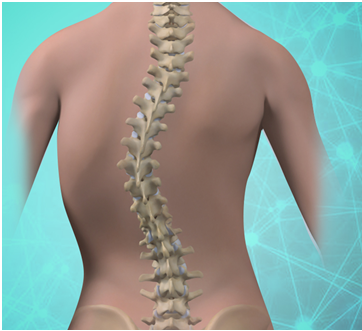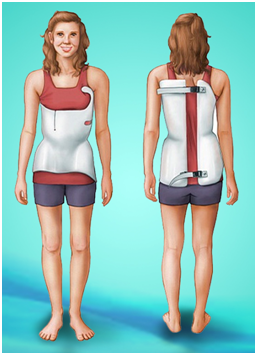Scoliosis Treatment in Gurgaon
Have you observed your child have tilted, uneven shoulders or an uneven waistline, or one hip higher than the other? This condition is generally observed during the growing years, especially when the child reaches adolescence. As a parent, it is advisable to be very observant of such signs and seek a pediatric orthopedic surgeon’s consultation without further delay!
Dr. Ratnav Ratan is a leading pediatric orthopedic doctor in Gurgaon, and an expert in treating scoliosis conditions is available for those who wish to consult him for this condition.
Scoliosis – An overview
A scoliosis patient may have a C or an S-shaped curve occurring mainly in the upper and lower back or anywhere in the spine. This condition may strike at any age. If it strikes in children below three years of age, the condition is known as infantile scoliosis or Idiopathic scoliosis.
This spine condition becomes prominently visible in early adolescence or late childhood – children in the age group of 10 -12 years. The patient in this condition may lean on one side or have uneven shoulders or hips. Females are likely to have this condition as compared to males.

The following symptoms are visible in infants with scoliosis
• Lying in a curved position, preferably on one side
• A bulge on one side of the chest
• Shortness of breath and chest pain, if there is an issue in the heart and lungs
Any delay in treating the scoliosis condition can lead to improper functioning of the heart and the lungs in the infant at a later stage. In infants, scoliosis is related to spina bifida, cerebral palsy, or muscular dystrophy.
If an infant does not receive scoliosis treatment on time, there will be more at risk of problems later in life, such as impaired heart and lung function.
If the patient is in the age group of 10 – 18 years, then the scoliosis condition is termed adolescent idiopathic scoliosis, and the visible symptoms could be
• Off-center position of the head
• Ribs on either side are at different heights
• Clothes hang oddly at the shoulders
• Shoulder blades at uneven heights
• Leaning on one side posture of the patient
• Varying length of the legs
Diagnosis of Scoliosis
The pediatric orthopedic surgeon will conduct a physical examination of the patient. The patient will be asked to do the ‘Adam’s forward bend test,’ a special screening test for scoliosis. The patient will have to bend forward with arms hanging free, knees straight, and feet together. The surgeon will observe the patient from behind to notice the shapes of the ribs on each side and spinal deformity. The surgeon will also check for abnormal neurological findings for limb-length discrepancies and physical issues.
The doctor may suggest an x-ray to get a clear picture of the spine and exact curvature point.
If the curve in the spine is more than 10 degrees, then the patient is said to have scoliosis.
Treatment of Scoliosis
Multiple factors are considered when planning the scoliosis treatment of the patient:
• The age of the patient
• The location of the curve in the spine – Curve in the middle area of the spine is likely to worsen faster than that located in the upper or lower section of the spine
• The severity of the curve
• Bone Maturity – If the patient’s bones have fully matured, then there a few chances that the spine will worsen.
Do visit Dr. Ratnav Ratan, the Best Orthopedic Doctor in Gurgaon, for scoliosis treatment and spinal issues in children and young adults.
In the initial stages, the pediatric orthopedic surgeon will begin with a non-surgical treatment which is as follows –
If the patient is nearly an adult and the spinal curve is less than 25°, then it is recommended to observe the patient and get medical check-ups are done every six months or annually.
Bracing
If the patient is in the adolescent stage and the spinal curve is between 25° and 45°, bracing is recommended to prevent the curve from bending further. The sole intent here is to avoid surgery.Bracing is known to have significantly reduced the progression of curves and the likelihood of performing a corrective surgery.
There are several types of braces available, which are customized as per the patient’s body. Most surgeons recommend underarm braces for convenience and support. The orthopedic surgeon will suggest which type of brace should be worn and for how long.

Surgical Treatment
Spinal Fusion is a surgical procedure for treating scoliosis and is suggested if the patient’s curve is nearly 50° or more and the bracing treatment did not yield desired results. Further, the curves could lead to impairment of the functioning of the lungs.
The curved spinal bones are realigned in a spinal fusion procedure. Bone grafts are small pieces of bones that are placed between vertebrates that require fusing. Over a period, these bone pieces grow together. At the same time, metal rods are also used to keep the bones in place till they fuse as required.
Recovery
If the procedure is performed on a child-patient, then the child can walk brace-free a couple of after the surgery. If all goes well, the child can attend school and resume everyday living in four weeks.
Post Spinal Fusion Surgery
Spinal fusion surgery has had promising results as it helps to straighten the curve, stops the curve from growing, and patient’s image improves. Young patients, especially children, can return to active sports, but they should avoid playing contact sports.
Moreover, spinal fusion surgeries do not hamper the future or pregnancy chances of the girls who have scoliosis.




